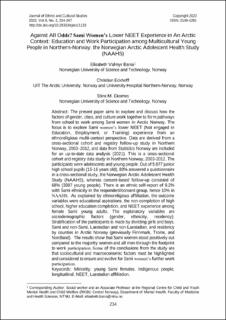| dc.contributor.author | Bania, Elisabeth Valmyr | |
| dc.contributor.author | Eckhoff, Christian | |
| dc.contributor.author | Ekornes, Stine M. | |
| dc.date.accessioned | 2023-02-27T13:19:58Z | |
| dc.date.available | 2023-02-27T13:19:58Z | |
| dc.date.created | 2022-06-20T09:53:24Z | |
| dc.date.issued | 2022 | |
| dc.identifier.citation | Journal of Ethnic and Cultural Studies (JECS). 2022, 9 (2), 234-247. | en_US |
| dc.identifier.issn | 2149-1291 | |
| dc.identifier.uri | https://hdl.handle.net/11250/3054309 | |
| dc.description.abstract | The present paper explores Sami women’s lower NEET (Not engaged in Education, Employment or Training) experience in an ethnoreligious multicontext perspective. Data are derived from a cross-sectional cohort and registry follow-up study in Northern Norway, 2003–2012, and data from Statistics Norway are included for an up-to date data analysis (2021). This is a cross-sectional cohort and registry data study in Northern Norway, 2003-2012. The participants were adolescents and young people. Out of 5 877 10th graders 83% answered a questionnaire in a cross-sectional study, the Norwegian Arctic Adolescent Health Study (NAAHS), whereas consent-based follow-up consisted of 68% (3987 young people). There is an ethnic self-report of 9.2% with Sami ethnicity in the respondent/consent group, hence 10% in NAAHS. The outcome variables were educational aspirations, non-completion of upper secondary school, tertiary education, and NEET experience among female Sami young adults as explained by ethnoreligious affiliation. The explanatory variables are sociodemographic factors (gender, ethnicity, residency). Stratification of the participants are made by dividing girls and boys, Sami, and non-Sami, Laestadian and non-Laestadian and residency by counties in Arctic Norway (previously Finnmark, Troms and Nordland). The results show that Sami women stood positively out compared to majority women and all men through the footprint to work participation. Some of the conclusions from the study is that sociocultural and macroeconomic factors must be considered to create means for Sami women’s work participation. | en_US |
| dc.language.iso | eng | en_US |
| dc.publisher | Center for Ethnic and Cultural Studies | en_US |
| dc.rights | Navngivelse-Ikkekommersiell 4.0 Internasjonal | * |
| dc.rights.uri | http://creativecommons.org/licenses/by-nc/4.0/deed.no | * |
| dc.title | Against All Odds? Sami Women’s Lower NEET Experience in An Arctic Context: Education and Work Participation among Multicultural Young People in Northern-Norway, the Norwegian Arctic Adolescent Health Study (NAAHS) | en_US |
| dc.title.alternative | Against All Odds? Sami Women’s Lower NEET Experience in An Arctic Context: Education and Work Participation among Multicultural Young People in Northern-Norway, the Norwegian Arctic Adolescent Health Study (NAAHS) | en_US |
| dc.type | Peer reviewed | en_US |
| dc.type | Journal article | en_US |
| dc.description.version | publishedVersion | en_US |
| dc.source.pagenumber | 234-247 | en_US |
| dc.source.volume | 9 | en_US |
| dc.source.journal | Journal of Ethnic and Cultural Studies (JECS) | en_US |
| dc.source.issue | 2 | en_US |
| dc.identifier.doi | 10.29333/ejecs/1133 | |
| dc.identifier.cristin | 2033261 | |
| cristin.ispublished | true | |
| cristin.fulltext | original | |
| cristin.qualitycode | 1 | |

